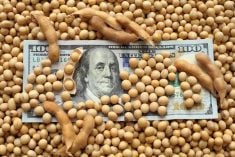New full-year data on Canada’s farm cash receipts in calendar 2022 show how increased commodity prices last year more than offset the drop in quantities sold.
Statistics Canada on Tuesday released figures showing Canadian farm cash receipts in 2022 at $94.9 billion, up 14.1 per cent from 2021, including crop receipts of $53.9 billion (also up 14.1 per cent), livestock receipts of $33.6 billion (up 12.1 per cent) and direct payments from crop insurance and other programs at $7.345 billion (up 23.6 per cent).
Each of the provinces in 2022 logged increases in total farm cash receipts on the year, led by Alberta (up $3.5 billion at $22.2 billion), Ontario (up $2.3 billion at $21.7 billion) and Saskatchewan (up $1.9 billion at $21.03 billion). New Brunswick posted the biggest percentage gain on the year, up 31.8 per cent at $1.31 billion.
Read Also

U.S. grains: CBOT soybeans, corn, wheat fall in USDA data aftermath
Chicago grains took a dive on Friday, following a closely watched U.S. government crop report and the release of export data that could provide clues into Chinese buying.
Reduced crop marketings in 2022 stemmed from low beginning inventories for most crops at the start of the calendar year, despite better growing conditions relative to Western Canada’s drought-dented 2021, StatCan said.
For example, cash receipts in wheat (other than durum) came in at $9.202 billion in 2022, up 28.2 per cent from 2021, due to a 42 per cent increase in price against a 9.7 per cent decline in marketings. Wheat exports were also down on the year, StatCan said, but the value of those exports was up 21.9 per cent.
Canola followed a similar track, posting total 2022 receipts of $13.7 billion, up 13.4 per cent on the year, with prices up 38.9 per cent against an 18.4 per cent drop in marketings.
Outliers among crops included soybeans — which saw a 30.1 per cent increase in receipts on increases in both prices and marketings — as well as durum, flax and dry beans, each of which saw declines in total receipts compared to 2021.
Among livestock, cattle marketings were near flat at an increase of just 0.5 per cent on the year, but higher prices (up 14 per cent) led to total cattle receipts of $10.8 billion, up 16.4 per cent.
Hog receipts, meanwhile, were up 4.4 per cent on the year at $6.5 billion, with prices up against declines in both slaughter and export marketings, StatCan said. Sheep/lamb receipts were down 7.9 per cent on the year at $229 million.
Supply-managed commodities’ receipts came in at $14.1 billion for 2022, up 12.8 per cent on the year, with dairy up 11.4 per cent at $8.2 billion on an 11.3 per cent increase in prices, and poultry/egg receipts up 14.6 per cent at $5.94 billion.
Among program payments, crop insurance made up the bulk of receipts in 2022 at $4.897 billion, up 30.6 per cent from 2021. Over 90 per cent of crop insurance payments went to Alberta, Saskatchewan and Manitoba. Among other programs, total AgriStability payments were up 10.9 per cent on the year at $406 million. — Glacier FarmMedia Network















